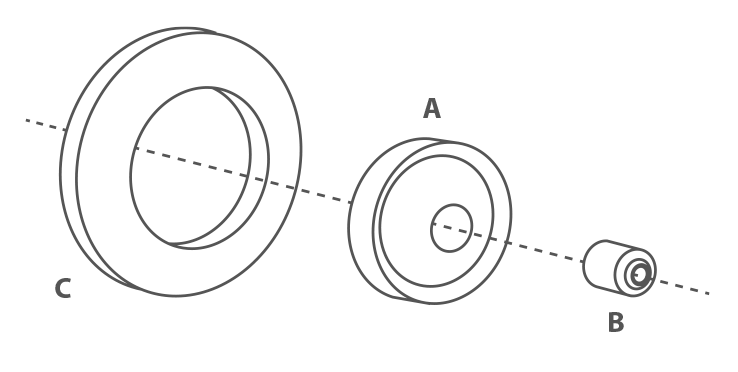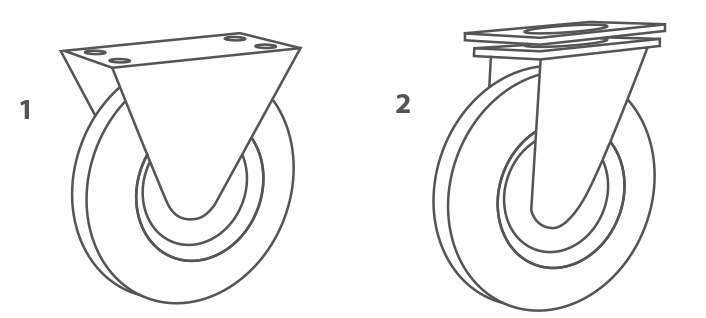Frequently Asked Questions
How does a wheel work?
Wheels
The parts of a WHEEL are A the wheel disc, B the hub as a receptacle for the axle, the rim and C the tread (tire).
By connecting the hub to a body, the wheel becomes a roller, allowing it to be connected to an object that needs to be moved and act as a means of propulsion. The fork includes the fork itself, the axle mount and the wheel mount, possibly including a slewing bearing (swivel head) and a locking mechanism.


What's the difference between a fixed wheel and a swivel wheel?
Fixed wheel and swivel wheel
In case of fixed wheels, the fork is locked in a single direction and attached to the object above the wheel axle. Fixed wheels benefit movement in one direction, but, as opposed to swivel wheels, they are not very manoeuvrable.
The swivel wheel features a slewing bearing on the fork, which connects it to the object. Due to the horizontal distance between the centre of the slewing bearing and the wheel axle, this type features an extension. The swivel fork makes the wheel highly manoeuvrable, and the extension increases control and stabilises the wheel when moving in a single direction.

Which bearing types are available?
Wheel bearing
The movability of the wheel depends on the bearing of the wheel axle in the hub. The most common wheel bearings are:
- Slide bearings, often taking the form of plastic boxes between the hub and the axle. This is the most straightforward bearing type, but it is also the least durable.
- Roller bearings, which feature steel rollers in a plastic or steel cage that roll between the hub and the axle. Roller bearings run more smoothly and feature a higher load capacity than slide bearings.
- Ball bearings feature one or more rings with steel balls between the outer and inner rings. Ball bearings have the lowest friction resistance and can handle heavier loads and higher rolling speeds. This particularly goes for precision ball bearings (deep-groove ball bearings, with reinforced grooves as guides for the balls).
Depending on the load, tapered roller bearings, self-aligning bearings and other types of wheel bearings may be used.
The appropriate wheel bearing in question depends on the starting and driving resistance, the required load capacity, the frequency of use and the rolling speed of the wheel. The specific accessories of the bearing (such as lubrication or a protective cover) depend on the conditions in the environment of application.

How does a swivel bearing work?
Swivel bearing
The manoeuvrability and ease of movement of a swivel wheel primarily depend on the structure and stability of its slewing bearing. To allow for greater load capacity and mobility in case of dynamic loads, most swivel bearings feature two offset balls and cages. Slide bearings are used for swivel wheels for lighter loads that feature a pin insert. These are used in the furniture sector, for instance.
The appropriate swivel bearing and its accessories depend on the same criteria that apply to the wheel bearing.
Special swivel wheel bearing
- Pressed steel swivel fork
- Triple-screwed, with waterproof, special double ball bearing.
- Without centre bolt, but with heavy screw plate.
- High load capacity thanks to the significant raceway diameter.
- With permanent lubricant.
Which mount types are available?
Mounts
The mount options of a wheel depend on the base of the object that needs to be moved (it may have a base plate, for example, or a stand), as well as the required stability of the entire construction:
A) Screw plate with equidistant holes fit for screwing the body onto the object.
B) Adjusting screw on the fork/slewing bearing to fix the body to the object.
C) Rear hole in the fork/slewing bearing for a connecting screw, bolt, etc.
D) Pin on the fork/slewing ring that can be connected to a tube, using a clamping ring or expander, for instance.

What determines the height of a wheel?
Height
The total height of the wheel is the available distance between the point where it touches the ground and the point where the fork is connected to the object. If the total height is set, the size of the wheel, the fork height and the wheel height need to be aligned optimally. Likewise, the height of the swivel bearings as variable elements should be optimally coordinated. Larger wheels reduce the rolling resistance.
What determines the load capacity of a wheel?
Load capacity
The load capacity of wheels depends on their material composition (the type and consistency of the plastic or metal, for example) combined with their construction (such as the bearing type, tires, single or double-wheel setup). This is what the information about the maximum load capacity refers to. Specific operating conditions (such as the temperature or chemical influences) may also affect the load capacity. As such, we recommend only using 75% of the specified load capacity to ensure a safety margin.
The required load capacity can be calculated using the following formula: Weight of the vehicle + weight of its cargo, divided by the number of load-bearing wheels, plus safety margin.
What tread options are available?
Tread
The tread is the outer layer of the wheel, the part that actually rolls over the ground. The width of the tread is called the tread width.
The material used for the wheel depends on the durability, load capacity and resistance of the wheel. Whether the outer ring of the wheel should be equipped with a tread (tire) and which tread type this should be depend on additional parameters, such as the condition of the road surface (starting and rolling resistance and the pressure and wear sensitivity of the surface), chemical and physical operating conditions, suspension and sound comfort.
Some polyamide or steel heavy-duty wheels, plastic furniture wheels or metal transport wheels perform better without a tread, as this makes them more robust and resilient. However, most wheels do need a tread to protect floors, support loads and increase the manoeuvrability of vehicles.
The most common treads are solid rubber tires, elastic solid rubber tires or polyurethane grooves, some of which are fixed to the wheel, while others are moulded on. Pneumatic tires are used in case of uneven surfaces in situations that require exceptionally low rolling resistance and exceptionally high suspension comfort.
The hardness of the tread is measured in Shore.
Which brake types are available?
Brake and locking systems
Brakes reduce the speed of the wheels to control their movement. Desk chair wheels, for example, feature a brake depending on their load. Their power transmission usually takes place via the wheel disc or hub. Locking systems lock wheels and swivel wheels in a single position, so furniture, vehicles or machines can be kept in one place. They are usually integrated into swivel wheels and can be operated using foot pedals. The options include:
- Wheel locks, which block the wheel
- Directional locks, which lock the slewing bearing of the fork in a single direction without restricting the movement of the wheel
- Total locks that lock both the wheel and the slewing bearing.
Which wheel combinations are available?
Wheel combinations
The manoeuvrability of transport vehicles, machines and other wheeled objects can be controlled through the position of the wheels and by combining swivel and fixed wheels.
The most common combination entails four wheels of equal height positioned at the four corners of the object; two swivel wheels at the front and two fixed wheels at the rear. Similar to a car, this combination can manage turns and manoeuvre from side to side.
A combination of four swivel wheels of equal height offers even more manoeuvrability. However, without additional directional brakes, this combination makes it hard to move in a straight line.
Combinations with three wheels of equal height or with two slightly taller fixed wheels in the middle may also benefit manoeuvrability, but may increase the risk of the cargo toppling over.

What's the difference between plastic wheels and rubber wheels?
Plastic wheels
A plastic wheel can be made in two ways. Fully plastic wheels made of polypropylene (PP) or polyamide (PA) are moulded around the rim. The enormous pressure exerted by the machine leads to a sturdy connection, resulting in a wheel with a hard tread. Plastic wheels with a polyurethane (PU) tread are cast around the rim. This technique results in a wheel with a soft, plastic tread. HACO performs these processes internally. We constantly monitor the process and the end result. If necessary, we make adjustments and configure the temperature and pressure of the machines.
Wheels with a PP or PA tread are harder and suitable for level surfaces. PA wheels can handle larger loads thanks to the shatter-proof qualities of the wheel. Wheels with PU tread are more suitable for uneven surfaces. These wheels combine the properties of plastic with the elasticity of rubber.
HACO also produces heat-proof plastic wheels. These special wheels can handle high temperatures. They are produced under high-temperature and high-pressure conditions. The wheels are made of plastic types with different colours that are more resilient to heat.
Rubber wheels
Rubber wheels are produced in cooperation with an external manufacturer. The rim is produced at HACO and is delivered to the factory along with the mould. Here, the rubber wheel is attached to the rim. Afterwards, the wheel is delivered to HACO, where we naturally subject it to a quality check.
The rubber tires are available in black or grey. The plastic wheels, on the other hand, can be produced in any colour. The hardness of the rubber is measured in Shore. The hardness of the rubber is its relative resistance to indentation. The lower the number, the softer the tire. A softer tire is more stable on uneven surfaces.
What conditions can the wheels be used in?
Weather conditions and environmental requirements
The requirements for the design and accessories of the wheels when used for a specific application depend, among other factors, on climatological conditions (like temperature and humidity) and the chemical and physical environmental conditions (such as the presence of salt, oil or electric charge) at the location where they will be used. The frequency and duration of exposure to extreme conditions of a certain type should also be kept in mind.
The following overview can be used as an approximate, non-binding guideline. We would be happy to provide you with product-specific information and help you to optimally align the products’ qualities and your requirements.


